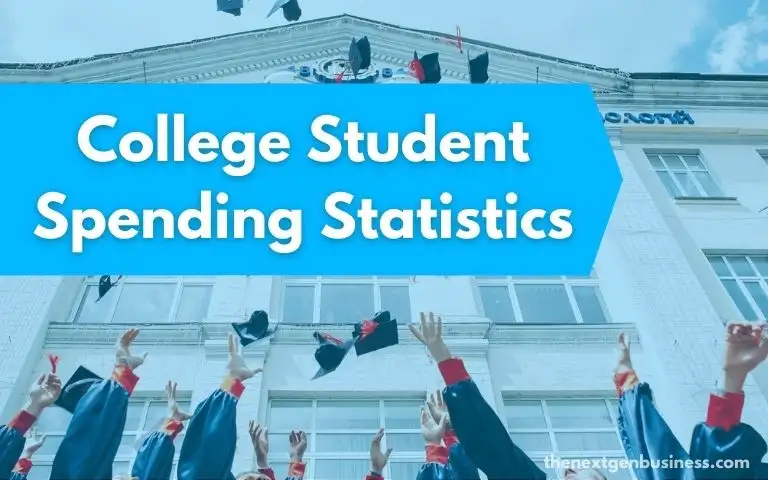
College is known for being quite expensive. This is especially true if you decide to go to a college in the United States. With college being so expensive, data has been released, itemizing different college student spending statistics.
One such statistic is the percentage of students who have had to skip meals to pay for textbooks and course materials.
You’ll likely find a couple of college student spending statistics that you have probably never even heard of before.
There are a wide variety of different expenses you need to take into account when going to college. These expenses range from laundry and tuition to books and transportation. Here are the 20 most fascinating college student spending statistics in 2022.
This post may contain affiliate links. For more information, see our disclosure policy.
Top 20 College Student Spending Statistics in 2022
Here is an overview of the most important college student spending statistics in 2022. These statistics include average weekly, monthly, and annual dollar amounts and percentages.
1. Full-Time Students Spend $1,240 on Books and Supplies
Source: Education Data Initiative
Spending $1,240 on books and supplies as a full-time college student makes sense. Although, there are ways to reduce this cost.
One of the best ways to reduce the amount you spend on books each year is to buy used books or rent.
2. $1,178 is the Average Monthly Rent of a Two-Bedroom Student Apartment
Source: Debt.org
This average monthly rent makes sense considering the current economic situation. Although affording $1,178 a month on rent can be tough for a college student just trying to scrape by.
The amount of rent you pay each month will usually vary depending on which state you’re in and the size of the apartment.
In 2022, Hawaii has the highest monthly rent at $1,617, and West Virginia has the lowest at $725.
Recommended: Simplify your finances today and get your direct deposits up to two days early with Chime!
3. The Average US In-State Public College Costs $11,631 Annually
Source: US News
Many opt to go to a public college that’s in-state out of financial necessity. On average, it costs almost three times less than going to a public university that is out-of-state.
4. Students Spend $28,238 Per Year On Out-of-State Public College
Source: US News
Out-of-state public college is significantly more expensive, compared to in-state college or community college. It is a little less than three times as much as its in-state counterpart.
The difference becomes even greater when compared to community college. That said, out-of-state public colleges usually will cost less than private universities.
5. The Average Annual Price of Community College in the United States is $3,730
Source: Education Data Initiative
Community college is typically utilized by students as a way to get credits before transferring to a four-year university and completing their degree.
Depending on which state you live in, it may even be offered for free. It is a fiscally responsible alternative to the more traditional path of going to college and entering a university immediately after high school.
6. Living On-Campus While Going to Community College Increases Cost by $6,000 a Year
Source: Education Data Initiative
If you decide to live on-campus while going to a public community college, you can expect to pay $6,000 per year.
This increase is expected because living on-campus will typically cost more than alternative living situations such as living with your parents.
7. College Students Spend $112 Per Month On Electricity
Source: Debt.org
Spending $112 a month on electricity is honestly expected and on par with the rest of the American population.
Compared to the average American spending $115.49, college students only pay a few bucks less on electricity each month.
8. The Average Cost of Going to a Private College is $38,070
Source: CollegeData.com
Going to a private college is often viewed as the most expensive option for getting a college education. With an average cost of $38,070 annually, viewing it in such as way is definitely justified.
9. Harvey Mudd College is the Most Expensive Private College in America ($77,339 per year)
Source: CBS News
The price of college keeps on increasing year after year. On average, the current college inflation rate is 8%. The truth of the matter is that the ever-increasing price of college does not show signs of slowing down anytime soon. Harvey Mudd College is just one example of many.
10. On Average, College Student Health Insurance Plans Cost Between $1,500 to $2,500 a Year
Source: Edmit
The cost of health insurance offered by some colleges ranges from $1,500 and $2,500 annually. It may be financially beneficial to compare your current health insurance plan to the one your college offers.
If it costs less, using their plan could actually end up saving you some money each year.
11. 4-Year Public In-State and Out-of-State College Students Have Additional Expenses of $16,138
Source: Education Data Initiative
If you go to a 4-year public college, you can expect to spend an additional $16,138 each year. This number just includes additional expenses and not tuition.
12. Students That Take Out Student Loans Will Pay an Average of $1,898 in Interest Each Year
Source: Education Data Initiative
When you take out student loans interest will eventually start accruing on those loans. On average, college students that have taken out student loans pay $1,898 in interest every year.
This may not seem like a whole lot initially. However, the interest adds up over time. Some people end up paying more towards the interest of their loans than towards the principal.
13. Almost 20 States Have Programs For Free Community College
Source: NerdWallet
If you’re looking at the expenses college students have and want to cut costs, your state may have a free community college program. Students will spend on average $3,730 on community college every year. That’s $3,730 a year you could be saving on college.
As a college student, you’ll want to try to save as much money as possible. You could not only be saving money going to community college, but you could save money banking as well.
You could start saving money today by opening a CIT Bank fee-free Savings Connect account. This means there is no fee for opening your account and there are absolutely no monthly service fees.
14. The Average College Student Spends Between $1,050 and $1,800 on Transportation
Source: Edmit
College students spend anywhere from $1,050 to $1,800 a year on just transportation. The amount students will have to spend on transportation will likely continue to increase as the price of gas rises.
15. It Costs $14,295 Per Semester To Study Abroad in College
Source: The Balance
The price of studying abroad will depend on a variety of factors. One of the most important factors is which country you plan on going to. That said, you can expect to pay around $14,295 each semester when studying abroad.
16. Students Going to a 4-Year College Will Spend Between $9,395 to $12,540 on Room and Board
Source: Education Data Initiative
4-year college students will end up spending somewhere between $9,395 and $12,540 on just room and board. If someone spends $12,540 on room and board to live at school for nine months out of the year, that ends up being 1,393.33 per month.
17. 11% of College Students Have Skipped Meals To Afford Books & Materials
Source: Education Data Initiative
The expensive nature of books and materials is well-known. But did you know that 11% of college students have had to skip meals just to pay for their college textbooks?
11% may seem like a small percentage. However, when you take into account that there are about 16.6 million United States undergraduate students, that number adds up quickly.
Assuming that this percentage is representative of the entire US undergraduate student population, that would mean 1.76 million students have skipped meals to pay for course materials and textbooks.
18. An Online Bachelor’s Degree Costs $51,091
Source: Education Data Initiative
Taking college classes online is becoming more popular as students take into account the convenience and financial upsides of online learning. In total, an online bachelor’s degree will end up costing you $51,091.
19. College Students Spend $40 a Month on Laundry
Source: Edmit
There are plenty of options when it comes to doing your laundry at college. On average, college students end up paying $40 a month on laundry.
20. 44% of Students With Federal Student Loans Expect Them To Eventually Be Forgiven
Source: Sallie Mae
Out of all students who have taken on federal student loans, 44% of them have the expectation that they will be forgiven. No one really knows if forgiving student loans is something the federal government will ever do.
But it is interesting that a little less than half of all students with these types of loans expect them to eventually be forgiven.
Summary
There are always costs associated with college, no matter the type of college, whether it’s a community college, public college, or private university.
College students can spend money on everything from laundry and electricity to textbooks and hanging out with friends.
If you found this article about college student spending statistics informative, consider checking out our other articles below.






